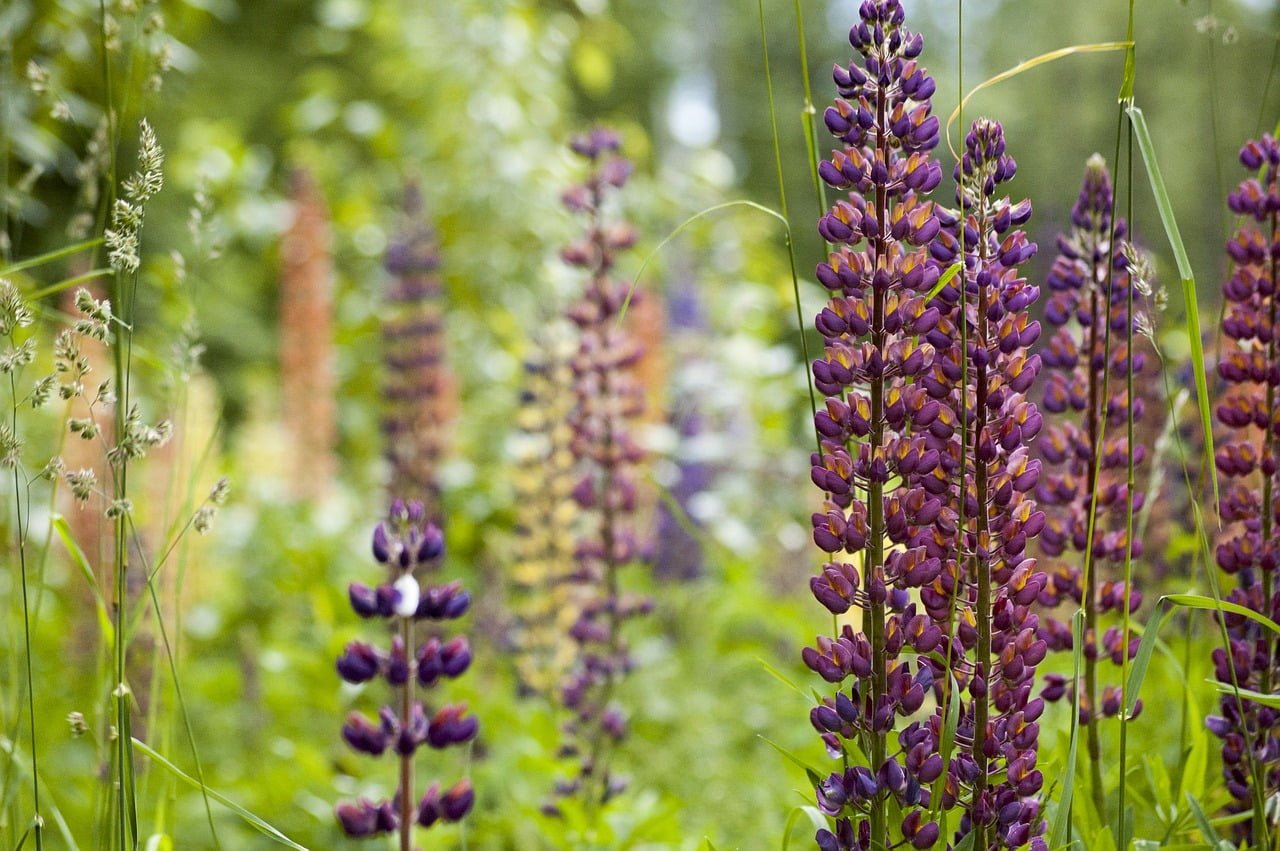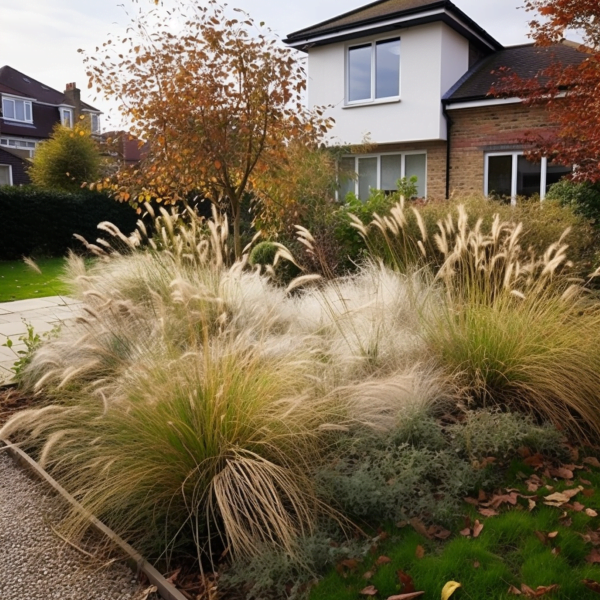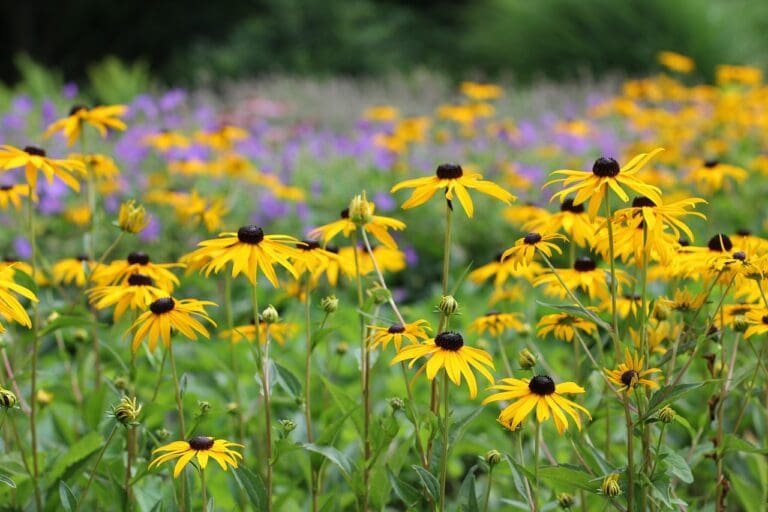There’s something inherently calming about nature’s spontaneous choreography of plants, where every leaf, flower, and blade of grass seems to find its perfect spot. What if you could capture that serenity and organic beauty in your own garden?
Enter the world of naturalistic gardens. Not merely a gardening style but a celebration of nature’s aesthetics, the naturalistic approach creates spaces that are not only pleasing to our eyes but also resonate with our souls.
Top Tip
Layer your plants by height and bloom time, ensuring continuous visual interest and reducing the need for frequent maintenance.
This post contains affiliate links which means we may make commission from any qualifying sales with no extra cost to yourself.
What Exactly is a Naturalistic Garden?
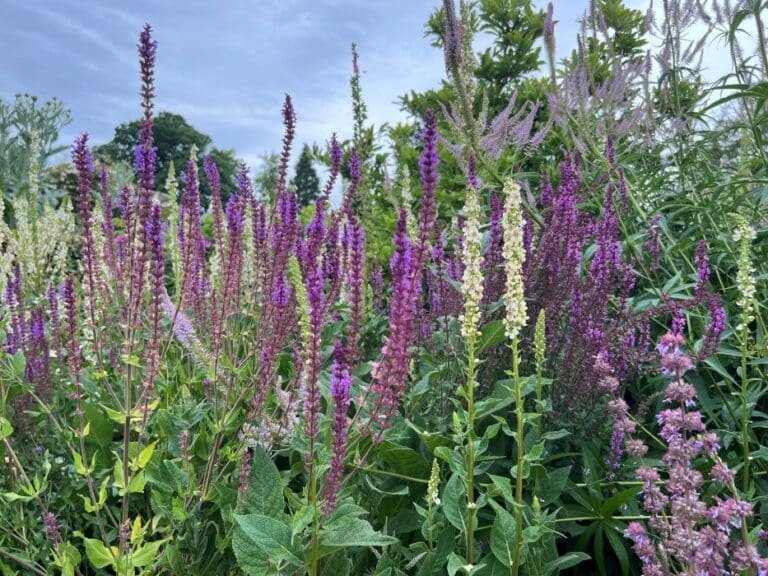
When the word ‘naturalistic’ is mentioned, many imagine wildflowers splashed haphazardly across a field, left to Mother Nature’s whims. But there’s a twist: these gardens, though mirroring nature, are designed with precision. They’re not just about beauty but about choosing plants for longevity and visual appeal throughout their life cycle.
Imagine a tapestry of perennials and grasses woven tightly together. These intermingling plants create exquisite, soft landscapes. Naturalistic gardens boast rhythm, structure, and carefully-selected plants that not only contrast in texture but shine even past their prime blooming period.
And, while this style isn’t new, it’s seeing a resurgence, partly thanks to renowned landscape designers like Piet Oudolf, the mastermind behind New York’s iconic Highline Garden and Somerset’s Hauser & Wirth garden.
The Advantages of Naturalistic Garden Design
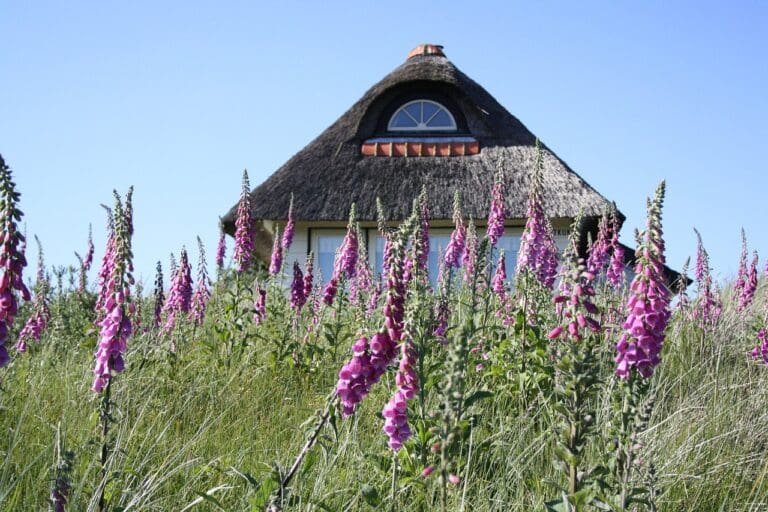
Once settled, naturalistic gardens are a dream for any green thumb:
Minimal upkeep: A little bit of editing here and there, but most of the work is cutting back perennials as winter wanes.
A winter wonderland: Letting plants keep their architectural seed heads offers a mesmerising view in colder months.
Biodiversity galore: Reduced interference means healthier soil, boosting garden biodiversity.
Wildlife haven: Those lingering seed heads? They’re winter food for garden visitors.
Piet Oudolf has wrote many fantastic books on naturalistic planting design.
Creating Your Own Nature-Inspired Oasis
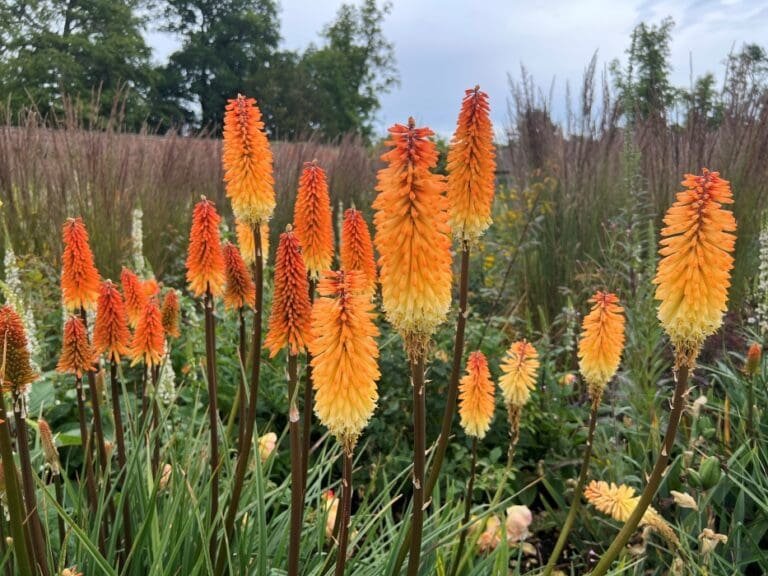
Keen to give it a try? Here are some key principles:
1. Plant as Nature Would
In a naturalistic garden, it’s all about achieving a sense of unbridled nature. Allow plants to drift into one another, forming an organic, unstructured tapestry. Don’t be afraid to let some plants self-seed. Over time, this spontaneous form of propagation can lead to delightful, unplanned groupings of plants that enhance the wild, untamed appearance of your garden.
2. Max Out on Plants
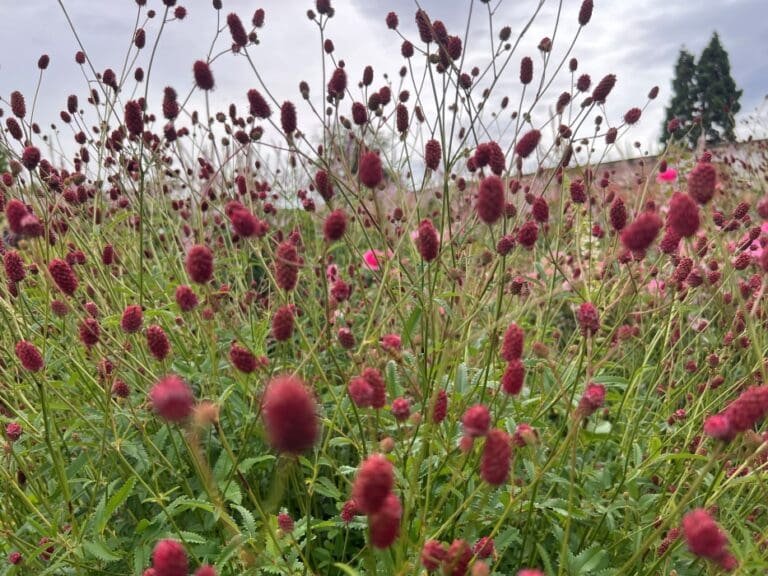
Densely planting your garden has multiple benefits. It not only creates a lush, full look reminiscent of natural landscapes, but also suppresses weeds. When plants are closely spaced, they compete for resources, leaving little room for unwanted invaders to establish. Plus, a dense canopy of leaves shades the soil, reducing water loss and protecting it from the sun’s harsh rays.
3. Harmonise with Repetition
In nature, certain plants naturally occur together, and you’ll often find the same combinations appearing repeatedly in a given area. Emulate this in your garden by repeating certain plants or groups of plants. This brings a sense of unity and harmony, guiding the eye smoothly through the landscape and creating a cohesive, well-considered design.
4. Plant for All Seasons
A garden should be a year-round source of pleasure. By carefully selecting plants, you can ensure there’s always something of interest, no matter the season. Spring can bring bulbs, summer offers an explosion of blooms, autumn showcases stunning foliage changes, and winter introduces structural interest through seed heads, grasses, and evergreens. Celebrate plants that transform through the seasons, like deciduous shrubs that offer flowers, vibrant autumn leaves, and striking winter silhouettes.
5. Layer It Up
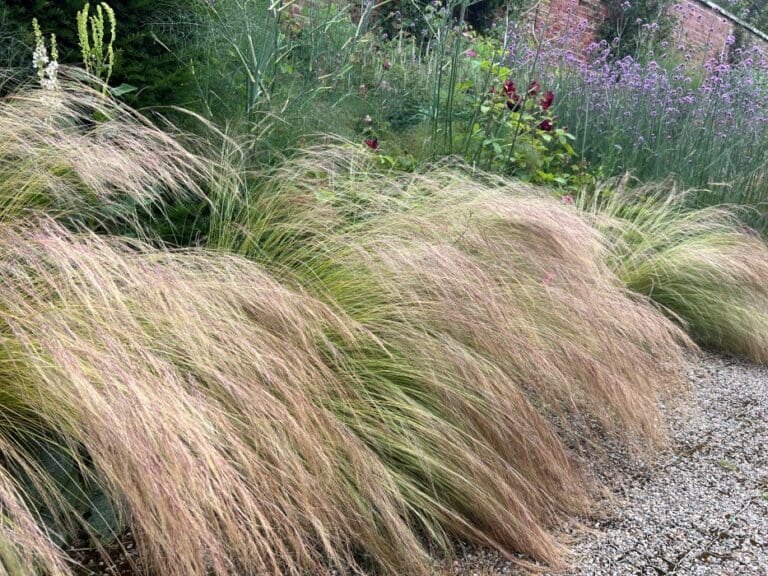
Using layers in your garden adds depth and interest. Incorporate a mix of perennials and grasses, and think vertically – low ground covers, medium-height perennials, and taller shrubs or trees. This layered approach not only creates a visually engaging space but also supports a wider range of wildlife. Different layers provide varied habitats for creatures such as birds, insects, and small mammals.
6. Simplicity in Design
In naturalistic gardens, the plants should be the stars of the show. If you incorporate hard landscaping, choose natural materials like gravel, stone, or wood that blend seamlessly with the surrounding planting. Similarly, any additional features such as water elements or sculptures should complement the natural theme. For instance, a pond edged with aquatic plants or a weathered sculpture can become part of the landscape rather than a distracting focal point.
A Layered Approach to Design
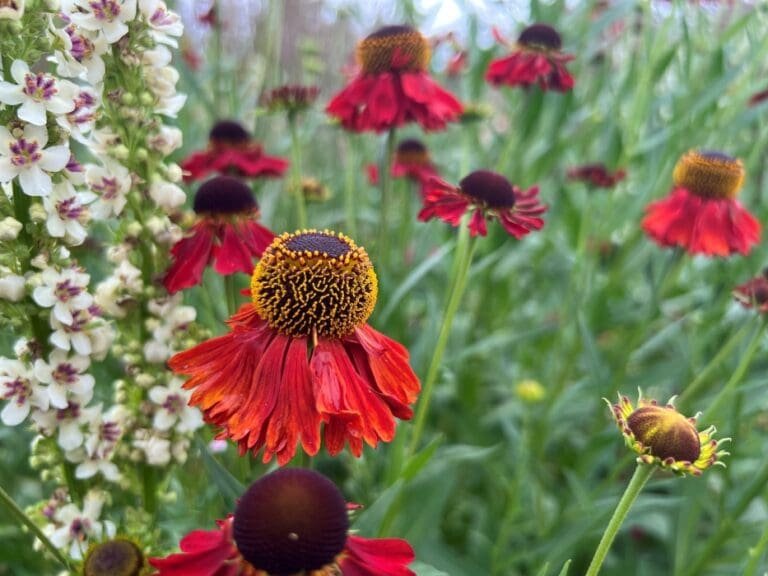
Naturalistic gardens thrive on layers:
1. Matrix Layer (The base)
Think of this as a green quilt enveloping the soil. Plants here, like the ‘green mulch’, shield against water evaporation and weeds.
2. Structure Layer (The heart)
This is where your perennials and grasses live. Their form, texture, and even their seed heads post-blooming should complement each other.
3. Scatter Layer (The dazzlers)
These plants pop up throughout the year in small clusters, injecting colour and vitality.
An example: For the matrix, you might use Sesleria Autumnalis, Carex Oshimensis, and Stipa Tenuissima. The main structure could feature plants like Salvia Nemorosa ‘Caradonna’, Echinacea Purpurea, and Stipa Gigantea. And for that scatter layer? Perhaps Allium Sphaerocephalon and Verbena Bonariensis.
Plant Profiles: Stars of the Naturalistic Garden
1. Echinacea purpurea (Purple Coneflower)
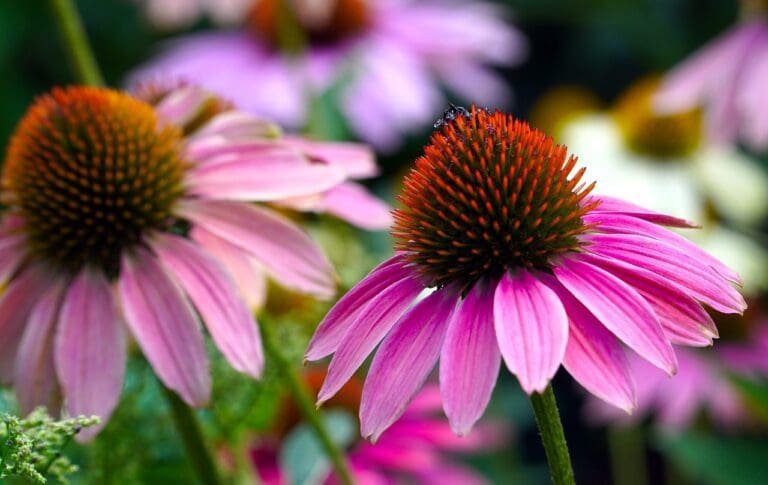
is renowned for its upright stems crowned with large daisy-like blooms. These radiant flowers come alive in the summer, while their seed heads stand as statuesque remnants in winter. Besides being a visual treat, they’re a magnet for pollinators and show commendable resilience during droughts.
2. Stipa Gigantea (Giant Feather Grass)
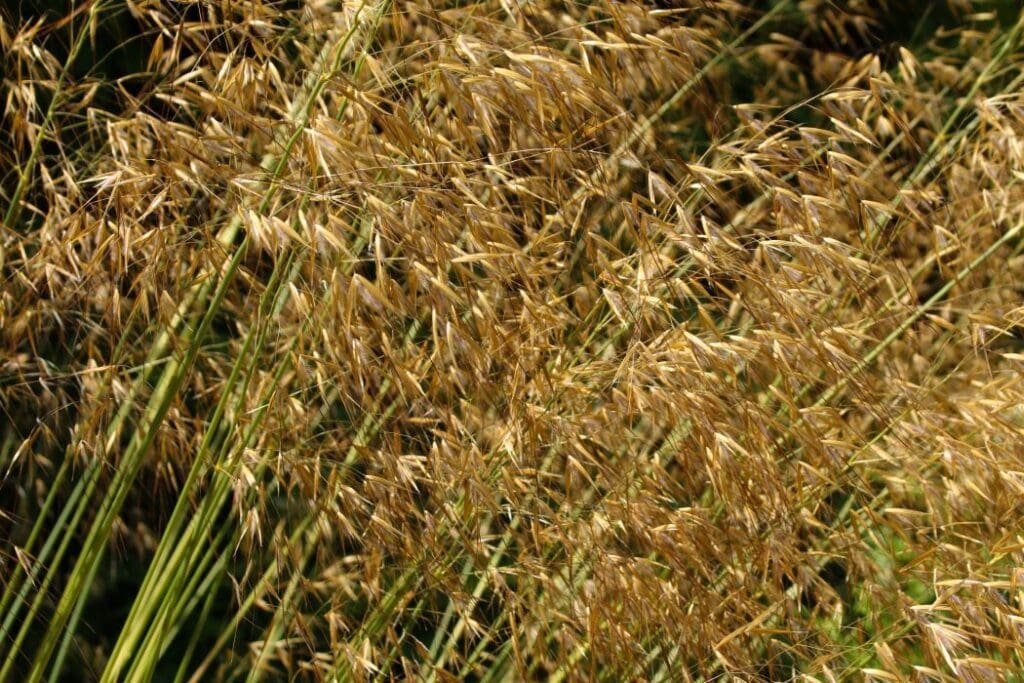
Stipa gigantea is truly a majestic sight in any garden. This towering grass is celebrated for its lofty, golden oat-like flower heads that catch the sunlight, creating a shimmering spectacle. Throughout the summer, these elegant panicles sway gently with the breeze, reaching impressive heights and providing a translucent screen effect. Being both drought-tolerant and deer-resistant, Stipa gigantea is not just a visual delight but also a practical choice for many gardens. When positioned thoughtfully, its tall stems can serve as beautiful focal points, drawing eyes and creating depth in the garden landscape.
3. Salvia nemorosa ‘Caradonna’ (Woodland Sage)
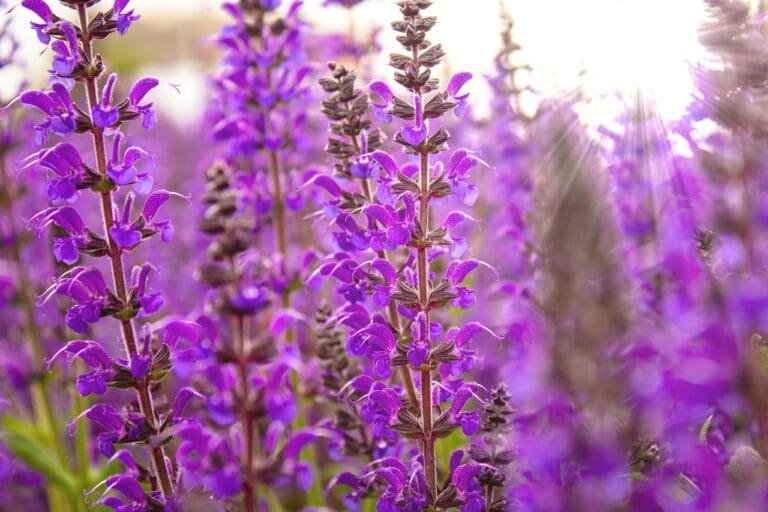
This hardy perennial is a late spring and summer bloomer that not only elevates garden aesthetics but also keeps deer at bay, all the while beckoning butterflies with its vibrant blooms.
4. Geranium ‘Rozanne’ (Cranesbill)
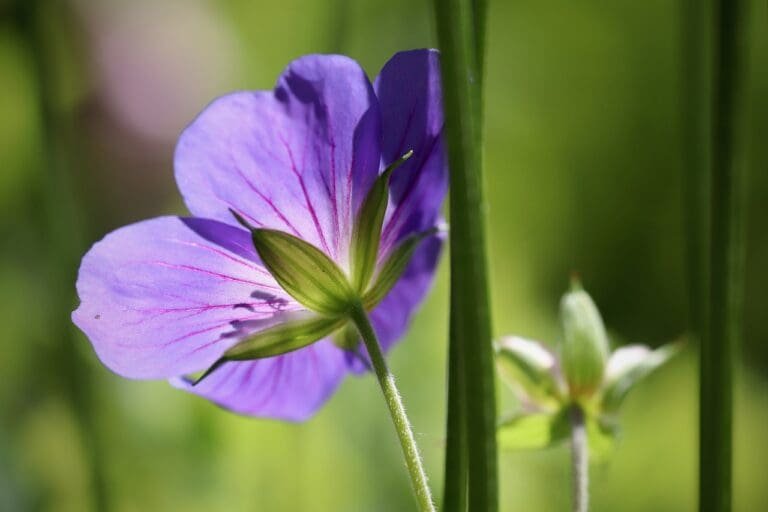
Geranium ‘Rozanne’ (Cranesbill) is a gardener’s dream with its mounding growth and generous spreading tendencies. Throughout the summer, it’s bedecked with blue-violet flowers, making it a delightful ground cover choice. It’s not just about beauty, though; this geranium variety is a testament to low-maintenance gardening.
5. Stipa tenuissima (Mexican Feather Grass)
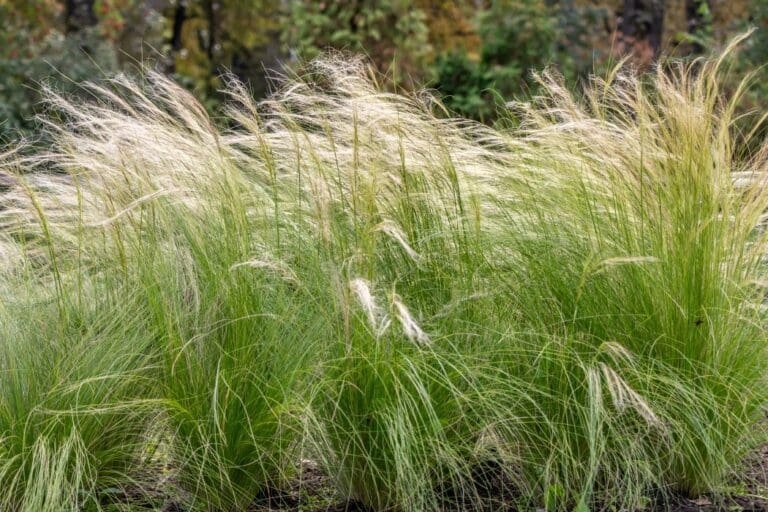
This grass, with its wispy blades and feathery panicles, lends a touch of elegance to any space it graces. Especially noteworthy is its ability to move gracefully with the wind and its tenacity during dry spells, showcasing its drought-tolerant nature.
6. Verbena bonariensis (Tall Verbena)
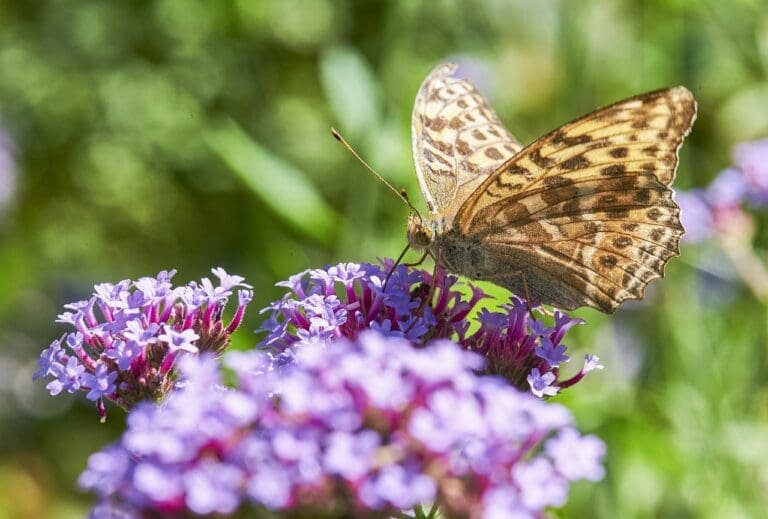
Verbena bonariensis reaches skyward with tall stems, each crowned with clusters of alluring purple flowers. From summer until the first frosts, this plant becomes a veritable butterfly hub. Its lofty blooms not only provide bursts of colour but also impart a light, airy feel to gardens.
When curating a selection for a naturalistic garden, it’s pivotal to consider regional conditions. While these plants are generally adaptive and exude a naturalistic charm, it’s always beneficial to ensure they harmonise with the local environment.
Want to Dive Deeper?
If the pull of the naturalistic garden is irresistible, these books can be your guide:
Wild: The Naturalistic Garden by Noel Kingsbury
Planting in a post wild world: designing plant communities by Thomas Rainer
More about Naturalistic Garden Design
Frequently Asked Questions
Q. What exactly is a naturalistic garden?
A naturalistic garden is designed to mimic nature’s spontaneous growth patterns. While it might look ‘wild’, it’s usually a product of careful planning to create a harmonious, organic appearance. It typically incorporates a mix of perennials and grasses with contrasting textures and forms.
Q. Is a naturalistic garden the same as a wildflower garden?
Not necessarily. While both styles celebrate nature, a wildflower garden focuses primarily on wildflowers, often native to the region. In contrast, a naturalistic garden can incorporate a broader range of plants, including grasses and non-native species, all carefully chosen to work harmoniously together.
Q. How is maintenance for naturalistic gardens compared to traditional gardens?
Naturalistic gardens can require less maintenance once they are established. The design often allows nature to take its course, especially in winter. However, some upkeep, like annual pruning and occasional editing of plants, might be necessary.
Q. Can I create a naturalistic garden in a small space?
Absolutely! While the scope and diversity might be more limited, the principles of naturalistic planting – layering, repetition, and using contrasting textures – can be applied to gardens of any size.
Q. Are naturalistic gardens eco-friendly?
Yes, naturalistic gardens can be eco-friendly. They often support local wildlife, reduce the need for pesticides and fertilisers, and require less water. Using native plants can further boost a garden’s ecological benefits.

